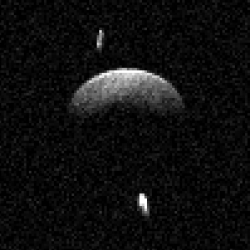Since asteroids have mass, they have gravity. And if you’ve got gravity, you can have moons. Several asteroids have been discovered in the outer Solar System with smaller asteroidlets circling them. But now the Arecibo radio telescope in Puerto Rico has turned up the closest example – a triple system just a mere 11 million km (7 million miles) from Earth.
Asteroid 2001 SN263 was revealed to be a triple system by Cornell astronomer Michael C. Nolan. The asteroid itself had been discovered back in 2001 as part of an automated survey. He and his colleagues captured radio images of the space rocks on February 11. By studying the images, they realized that they actually had a system of three objects.
The main central asteroid is roughly 2 km (1.5 miles) across. The larger “moon” is about half that size, and the smallest is about 300 metres (1,000 feet) across.
Asteroid systems like this have been seen in the Asteroid Belt, between Mars and Jupiter, but never so close. This allows scientists to image it with unprecedented detail.
As researchers find more and more near-Earth asteroids, they’re starting to realize that binary systems are actually quite common. According to Nolan, one in six near-Earth asteroids is a binary. Although, this is the first near-Earth triple system seen.
Multiple asteroid systems are very useful for astronomers; they provide the mass calculation. In a multiple object system like this, you can calculate the mass of each object by knowing the various periods (the time they take to complete an orbit). Researchers can then compare the mass of the binary objects to the brightness of single asteroids to estimate their masses as well.
One of the big unanswered questions: did the three objects form together, or were they captured later on? By watching the system over time, Nolan and his team will get a better sense if they’re orbiting on the exact same plane (like our Solar System). This will be evidence they formed together billions of years ago.
Arecibo is one of the best asteroid hunting tools available to astronomers; unfortunately, budget cuts in the United States has put the future of the facility in jeopardy.
Original Source: Cornell News Release


Funding should be found somewhere to keep this facility going. That fact could be driven home dramatically if our Earth ever gets smacked by a sizeable space rock.
This is AMAZING….
The social atmosphere currently in the US has negated much that resides south of the Rio Grande river. Unfortunately, that includes Arecibo. Program Bad JuJu no doubt. Utterly wasteful and shortsighted.
It is cool that a triple asteroid has been found quite recently after the Tinkerbell Galaxy discovery. Truth is always stranger than fiction!
on feb 12th at 9.31pm in dalkieth scotland while gazing under the not yet full moon a shadow caught my eye i raised my scope up to see what it was it was a big rock about a tenth the size of the moon slowly tumbling past this side of the moon it was such a beautiful sight i followed it for about 30 40 seconds from left to right cant help think it was one of these reported i seen can anybody help me